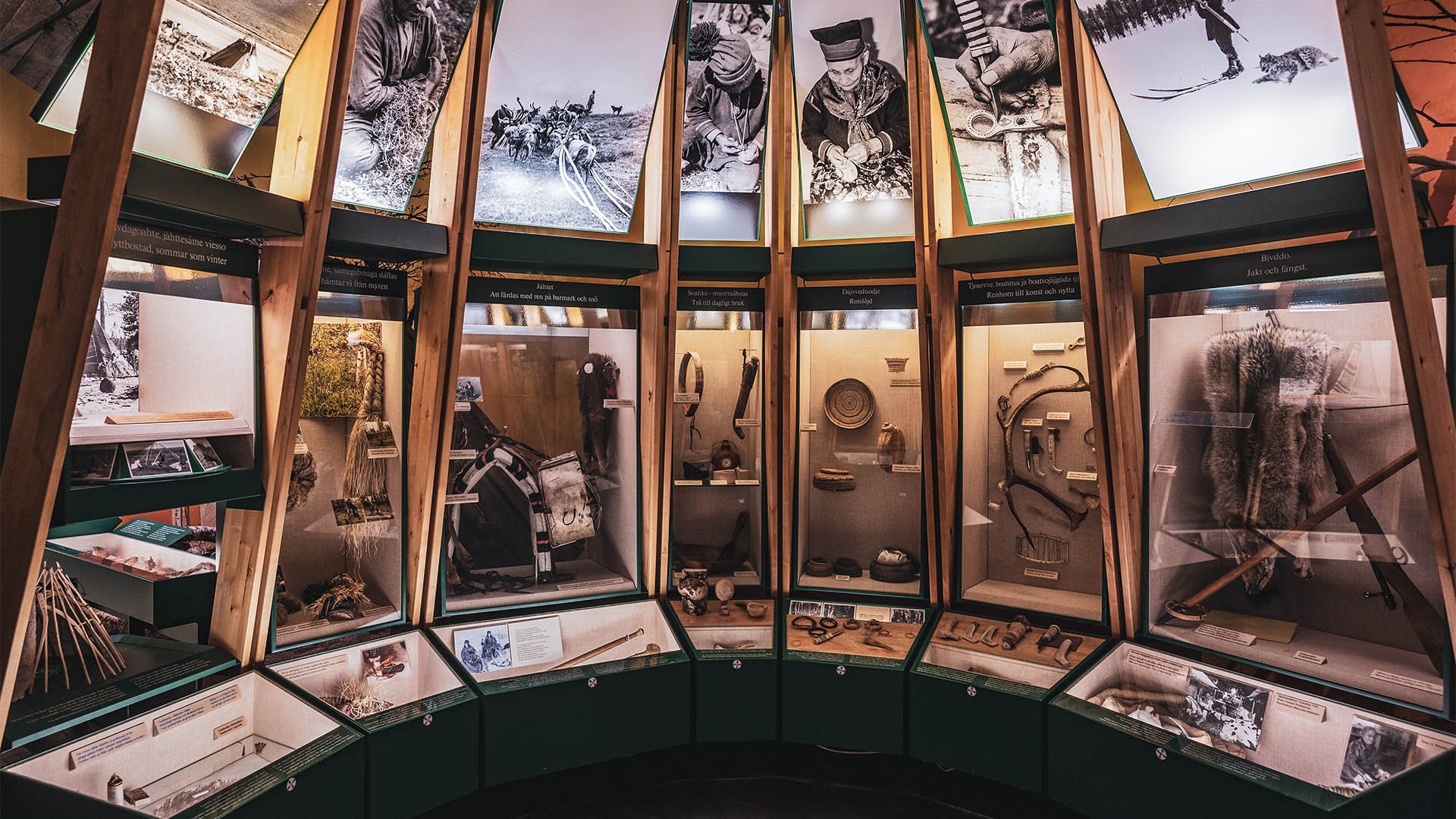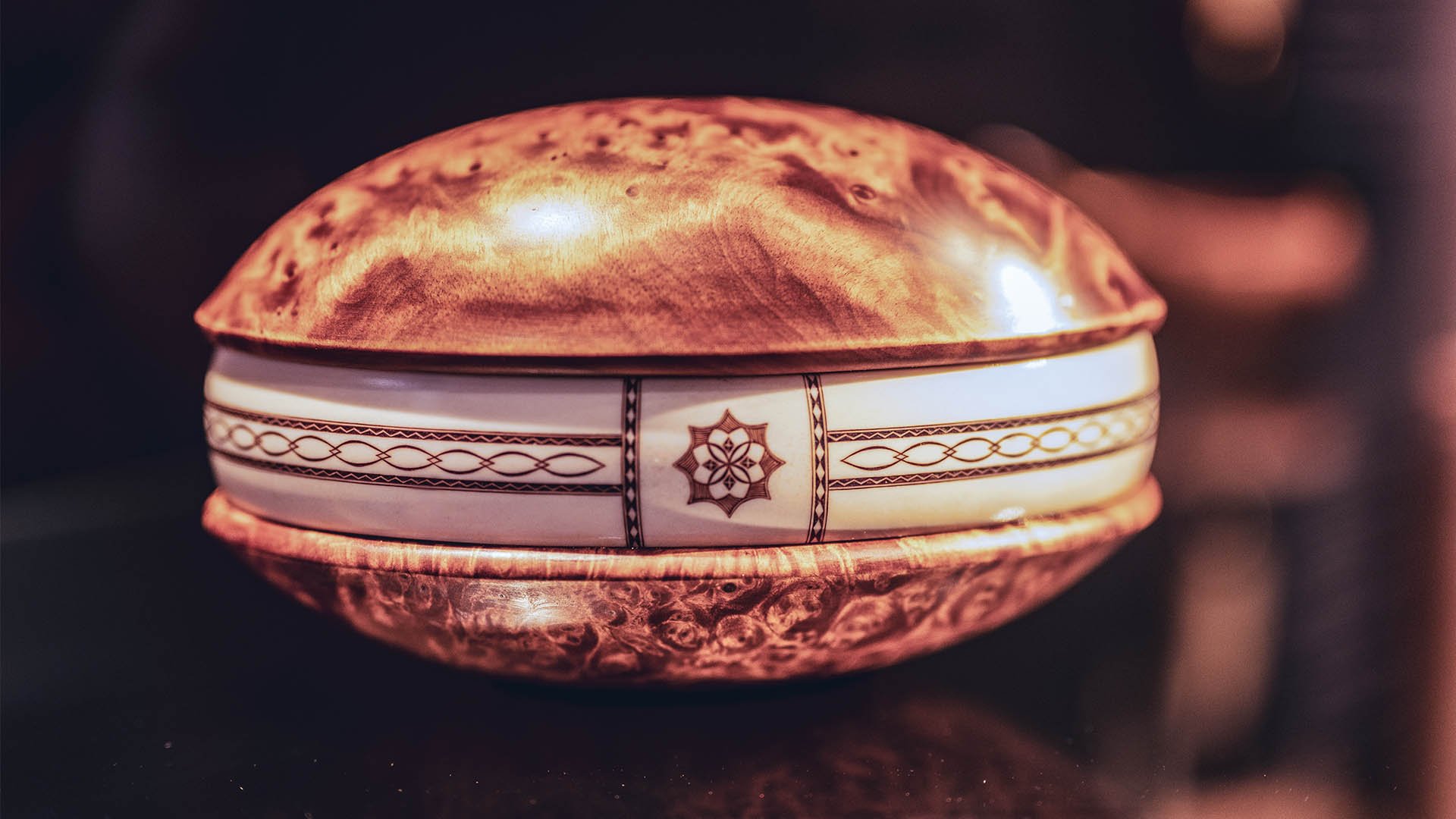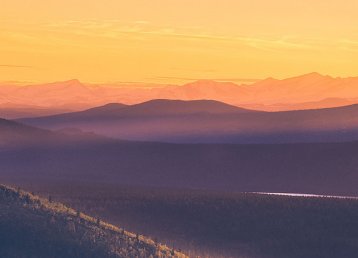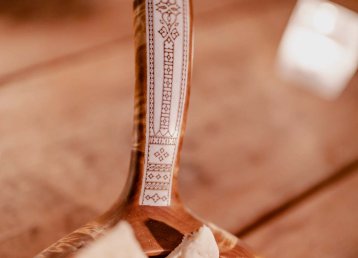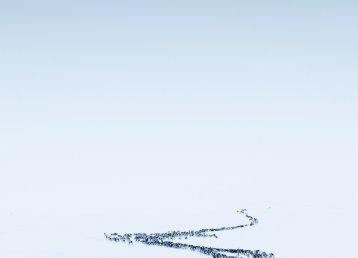What would a museum tell you, if it got the chance? Like in the film Night at the Museum where Ben Stiller plays night security guard Larry Daley, and the Museum of Natural History comes to life during his night shift. I’m standing in front of one of Lars J:son Nutti’s huge murals at Ájtte, marveling. In the bold color play, figures suddenly become visible, appearing out of what’s been hidden. I’m thinking that I would like to be here if the museum came to life, but at the same time, I wouldn’t. All museums have hidden stores that are not easy to talk about in another time, in another context. Perhaps that’s the reason why their collected knowledge becomes so important. Skull measurements, colonization, forced displacement – these things that have now taken a step into the open were forgotten and discarded in our own history for a long time. We’ll come back to this.
Elina Nygård
Artist and Head of Unit at Ájtte in Jokkmokk, Elina Nygård, steps out of the Sami hut, the lavvu, in the bright entrance. People used to scare their children to make sure they would behave. They said the gods lived in the hut, and it was forbidden to stomp around in the kitchen section.
— Adults used to tell me that I’d get false teeth when I got old if I jumped from one side to the other in the lavvu, so of course, we children tried that as soon as we were alone inside it.
— So, we’ll see what happens to my teeth, she says, laughing.
A demanding climate
We actually don’t even have to talk about the worst parts of our history to make things a bit uncomfortable among our plush sofas and microwaves. Life in the past, both as a Sami and as a settler, was hardly a bed of roses even if you didn’t get your head measured or move to a place where you didn’t understand the language. If the museum would come to life and you were here, many items and individuals would tell you how arduous it was to stay alive on the fringe of the Ice Age. About strategies to live, and how to survive, in a demanding climate.
— Settlers, immigrants as well as Sami who gave up herding reindeer, often lived a hard life. They had to be good at a lot of different things. Hunting, fishing, carpentry, wood chopping, berry picking, taking care of the animals and the farm. It certainly wasn’t easy, Elina continues.
Private collections
Ájtte Museum, just like Silvermuseet in Arjeplog, has its roots in one person’s private collections and interests. In the case of Ájtte, it was district police superintendent Erland Ström who had a magnificent collection of silver and antiques, and he wanted it to remain in Jokkmokk. In Arjeplog it was Dr. Einar Wallquist who collected items and documented the nomadic life. Erland Ström was a legendary chief of police, mountain man, and collector. Ström’s private collection was one of the foremost in the country when it came to Sami cultural objects. Just like Dr. Wallquist, Ström wanted his collection to stay in the region, to bring people joy and wonder.
Sami handicraft
I’m taking a stroll around Ájtte on a day in March and feel privileged to have Elina Nygård accompany me. She is educated as a teacher but has worked with Ájttes exhibitions for more than 20 years. My favorite exhibition at the museum is the one on Duodje, Sami handicraft, where you come across famous objects made by among others Asa Kitok, Jon Thomas Utsi, and Monica L Edmonson. The exhibition was curated by Katarina Spiik Skum and Sunna Kuoljok, and consists of more than 400 items with the power of enchantment – all this talent! When I ask Elina if she has a favorite exhibition she says:
— It’s tricky. It’s usually the latest one.
But this time, with Sielu bieđganeapmi, A Splintered Soul, it was difficult. How people were forcibly displaced. A social experiment and pen strokes across a map, changing the human soul so abruptly.
Also read
11 museums in Swedish LaplandWhen we enter the exhibition Elina is talking about, I understand what she means. It’s sparse, bright, and small. Much of the exhibition is transparent as if it were ‘invisible’ – as if it were of no importance to the world powers. The crows in the ceiling, hanging above the migrating people, is a picture from Britta Marakatt-Labba’s well-known piece of art Garjat – the Crows. Government power, sailing above the simple earthbound people like cawing, thieving crows.
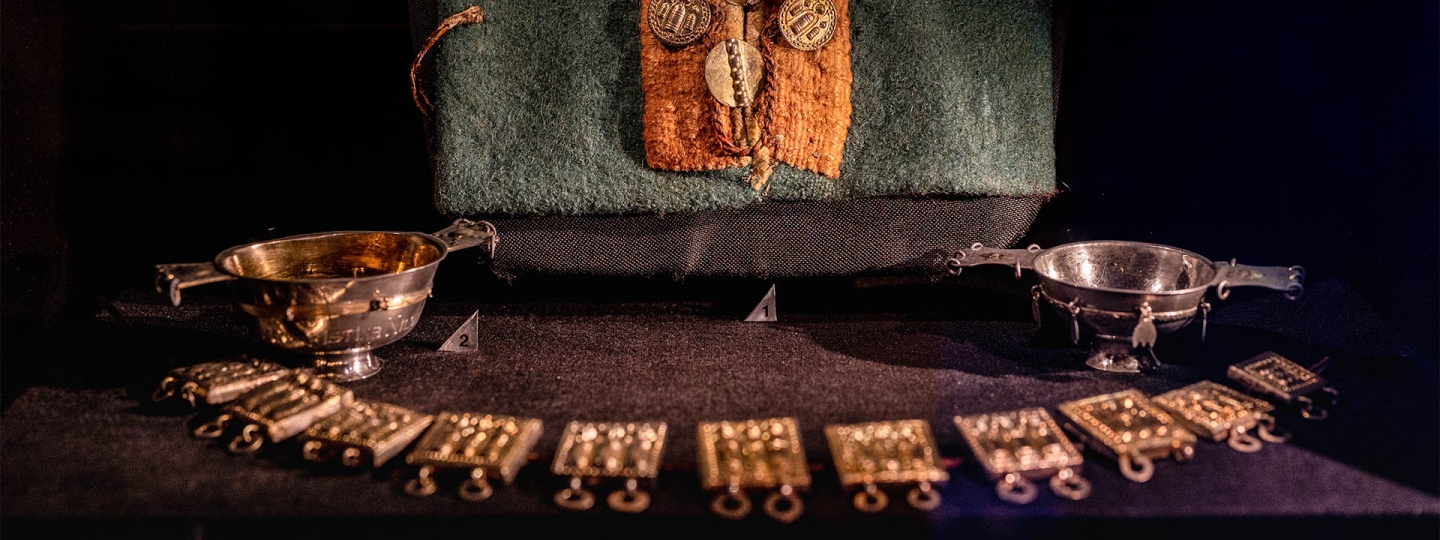
Silvermuseet
Silvermuseet in Arjeplog holds the biggest collection of Sámi silver in the world.
Wilderness romanticism
Dr. Wallquist himself called it ‘wilderness romanticism’: the reason why he, who grew up in Dalsland and studied in Stockholm, decided to take the position of provincial doctor in Arjeplog. And the reason why he stayed. Dr. Einar Wallquist just fell for the beauty of the place, and then he also fell for its people. He came to Arjeplog in 1922, shortly after the Spanish flu pandemic that had hit Arjeplog hard. Three percent of the population died from the Spanish flu, the worst epidemic Europe had seen since the Black Death. Before that, there was no doctor at all in Arjeplog. The nearest doctor if you needed one was 90 kilometers away, in Arvidsjaur. That’s how far it was to the pharmacy, as well. Einar Wallquist, known by the locals in Arjeplog as simply ‘the Doctor’, took up the position in August 1922. The year before he had done an internship in Sorsele, and somehow been infected by that ‘wilderness romanticism’. He served his town as a doctor for 40 years, and during that time he also collected cultural items and local objects, which eventually turned into a museum. It became Silvermuseet in Arjeplog. After 40 years as a provincial physician, the doctor became a museum curator – the curator of his very own museum.
Dr. Wallquist and his silver museum
After 40 years as a provincial physician in Arjeplog , Dr. Einar Wallquist became a museum curator – the curator of his very own museum.
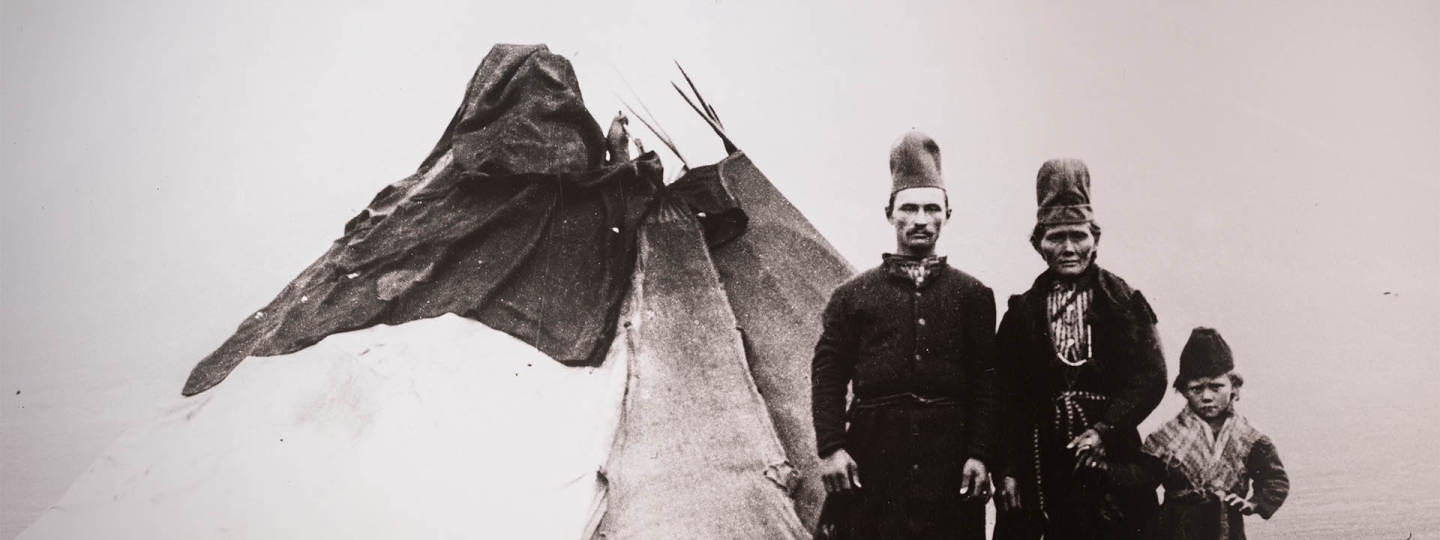
A harsch life
Dr. Wallquist just fell for the beauty of the place, and then he also fell for its people.
Silver
Silvervägen. Silverhatten. Silvermuseet. So many things revolve around silver in these areas. Why?
— There was the silver mine at Nasafjäll mountain with its terrible history, and there was all the Sami silver in the Sami world, with all its beauty, explains Malin Brännström, the museum director.
— Silver was important to the Sami; it was a good way of managing their income. They had a lot to trade with, furs not the least. The profits were invested in value-resistant silver. Besides, bling was important already back then.
— Today the museum holds the world’s foremost collection of Sami silver, which we are extremely proud of.
The silver collection contains objects and clothing that indicate great riches. I do wonder what it was like to go to a Sami wedding back then. But I also understand that life wasn’t always a party. The fact that weddings lasted for three days – it made sense if people had to travel – is surely a sign that if an opportunity came along, you might as well go all out. But there is also the time factor. As I’m taking in the exhibition, I wonder if I would have been able to cope with the slow pace of things. If my scrolling thumb and sensation-seeking brain would have managed to accept that in the morning, just like every morning, the only thing that mattered was to light the fire and wait for the coffee to boil.
Arctic research
Ambling around these museums for a few days in March, I often get stuck in front of an item, start reading the infographics, but then continue walking. Often thinking to myself: “I should give this more time, there’s so much to learn”. To people growing up in the inland regions of Västerbotten and Norrbotten, both Ájtte and Silvermuseet are very well known. Silvermuseet used to be housed within the walls of what was the old nomad school in Arjeplog. Today the museum has been expanded and modernized, and the premises are also home to the Institute for Arctic Landscape Research, INSARC. The research is interdisciplinary and separate from universities and colleges, which is unusual but provides a unique opportunity for independent research that’s anchored in the place itself. Just like the Silver Museum is an anchor for all our time. Not just for the past, with traces from the first humans in the area 10,000 years ago up until our present, but also for the future. Ájtte has grown in the same way, from an exhibition on silver and the Sami to an Arctic education center.
"The museum has been expanded and modernised, and the premises are also home to the Institute for Arctic Landscape Research, INSARC."
Slow changes
At Silvermuseet and INSARC as well as Ájtte they are convinced that there is a lot to learn from the Arctic lifestyle. Back in 1992, at the Earth Summit in Rio de Janeiro, the Convention on Biological Diversity was created alongside the Convention on Sustainable Development and Agenda 21. One of the things emphasized in that convention is how important it is to learn from history if we want to succeed. Local and traditional knowledge, or customs, are to be equated with scientific research results. People and professional groups possessing such local or traditional knowledge are among others the Sami, farmers, foresters, archipelago and inland lake fishermen, craftsmen, and others.
— I think it’s important to understand that even if this is a sparsely populated area, people have lived here for thousands of years, says Malin Brännström.
— To the untrained eye it looks like there’s never been anyone here, that it’s a wilderness. But if you know what you’re looking for, the traces are clear.
— This is a slowly changing cultural landscape, and that very slowness, that cooperation between man and nature, is something we have to learn from.
If a museum could tell stories, what would it tell us? I see a picture of Johan Abram Persson, skiing. I’d like to ask him what it felt like winning the Vasaloppet ski race in 1929. I’d also like to ask Kristina Ottiliana Persdotter from Ammarnäs what her wedding day in 1908 was like. Her picture taken on her wedding day is exhibited at Ájtte, along with her gahkti and amazing belt of silver handicraft. Did she live a happy life? Would she even understand what I meant by asking that? Is the word happy even the same now, as it was back then? Perhaps that’s the task of museums: they make us think about what’s at the back of our minds all the time anyway. Why did I become the way I am?

















